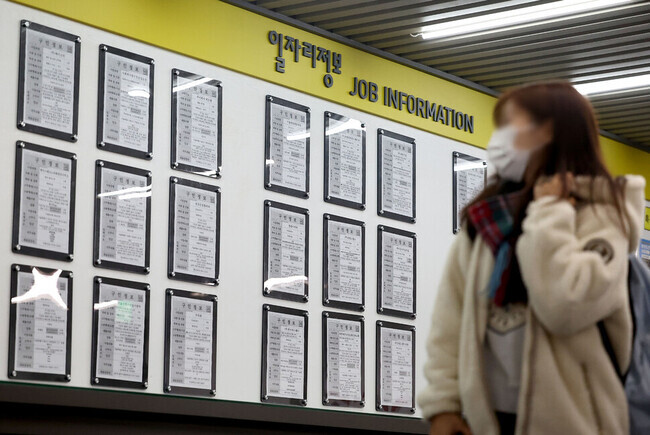hankyoreh
Links to other country sites 다른 나라 사이트 링크
“Unusually low”: IMF notes Korea’s record-low unemployment amid bottoming out growth

The unemployment rate in South Korea came out to 2.1% last month, the lowest the figure has ever been in the month of October. This means only 2 out of 100 economically active individuals were unemployed and unable to find work. South Korea is projected to record economic growth in the low 1% range for 2023, the lowest the figure has ever been in 14 years excluding the COVID-19 pandemic years, so what could account for the upturn in employment?
In a recently published staff report for South Korea, the International Monetary Fund dedicated an annex to understanding low unemployment in the country. Noting that South Korea’s unemployment rate “has fallen to historically low levels,” the report described the figure to be “unusually low” in the country.
The IMF focused on “labor market matching efficiency” as an explanation to this phenomenon. It argued, “Improved labor market matching efficiency has contributed the most to low unemployment since COVID.” In fact, according to the IMF’s analysis, matching efficiency lowered the domestic unemployment rate from 2021 to the first half of 2023 by an average of 1 percentage point.
This means workers looking for employment and corporations looking for manpower are able to come together more easily than in the past, quickly resolving the imbalance of labor supply and demand. The IMF noted, “The expansion of service sector jobs as COVID restrictions were lifted, together with the increase in labor force participation of females and the elderly, who are disproportionately likely to seek jobs in the service sector, might also have contributed to improved labor market matching efficiency more recently.”
In other words, the labor market may have been able to match labor supply more easily as jobs in the service sector, such as health care, welfare, food service, and lodgings, which significantly increased in number following the COVID-19 pandemic, do not require skills necessary in industries such as manufacturing.
An increase in jobs after positions went vacant early in the pandemic and slowing growth in the working-age population were also shown to have contributed to low unemployment. “Over the medium term, the unemployment rate is likely to remain lower than pre-COVID levels if the improvement in labor market matching efficiency proves to be largely structural and is sustained,” the IMF projected.
By Park Jong-o, staff reporter
Please direct questions or comments to [english@hani.co.kr]

Editorial・opinion
![[Editorial] Intensifying US-China rivalry means Seoul must address uncertainty with Beijing sooner than later [Editorial] Intensifying US-China rivalry means Seoul must address uncertainty with Beijing sooner than later](https://flexible.img.hani.co.kr/flexible/normal/500/300/imgdb/original/2024/0517/8117159322045222.jpg) [Editorial] Intensifying US-China rivalry means Seoul must address uncertainty with Beijing sooner than later
[Editorial] Intensifying US-China rivalry means Seoul must address uncertainty with Beijing sooner than later![[Column] When ‘fairness’ means hate and violence [Column] When ‘fairness’ means hate and violence](https://flexible.img.hani.co.kr/flexible/normal/500/300/imgdb/original/2024/0516/7417158465908824.jpg) [Column] When ‘fairness’ means hate and violence
[Column] When ‘fairness’ means hate and violence- [Editorial] Yoon must stop abusing authority to shield himself from investigation
- [Column] US troop withdrawal from Korea could be the Acheson Line all over
- [Column] How to win back readers who’ve turned to YouTube for news
- [Column] Welcome to the president’s pity party
- [Editorial] Korea must respond firmly to Japan’s attempt to usurp Line
- [Editorial] Transfers of prosecutors investigating Korea’s first lady send chilling message
- [Column] Will Seoul’s ties with Moscow really recover on their own?
- [Column] Samsung’s ‘lost decade’ and Lee Jae-yong’s mismatched chopsticks
Most viewed articles
- 1For new generation of Chinese artists, discontent is disobedience
- 2[Editorial] Transfers of prosecutors investigating Korea’s first lady send chilling message
- 3S. Korea “monitoring developments” after report of secret Chinese police station in Seoul
- 4Xi, Putin ‘oppose acts of military intimidation’ against N. Korea by US in joint statement
- 5[Exclusive] Unearthed memo suggests Gwangju Uprising missing may have been cremated
- 6N. Korean media upgrades epithet for leader’s daughter from “beloved” to “respected”
- 7Yoon says concern about biased diplomacy is being incited by “communist totalitarian forces”
- 8[Column] US troop withdrawal from Korea could be the Acheson Line all over
- 9[Editorial] Intensifying US-China rivalry means Seoul must address uncertainty with Beijing sooner t
- 10[Interview] Recalling seeing soldiers secretly burying bodies behind Gwangju Prison